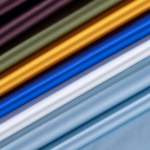Intro
In the realm of luxurious fabrics, the elegance and opulence of Duchess Satin have etched its name as an epitome of elegance. From its roots to its uses, this blog post unravels the enchanting world of Duchess Satin fabric.
Unearthing the Origins of Duchess Satin Fabric
Steeped in a rich history, Duchess Satin Fabric traces its beginnings to Zhejiang in China, gaining popularity due to its primary composition of exquisite silk. The fabric's use in the European noble circles, specifically by the Duchesses for their lavish attire, earned it its moniker. Setting itself apart from regular satins with its high-gloss finish and substantial feel, Duchess Satin acquired an elevated standing in the textile world.
Discerning the Unique Characteristics of Duchess Satin
Duchess Satin distinguishes itself through several unique features. One of the most noticeable is its high sheen, allowing it to radiate a dynamic lustre under different light intensities. This fabric also has a firm yet supple texture, ideal for creating well-structured garments while ensuring comfort. In addition, despite being weightier than its counterparts, it manages to retain a soft and sumptuous feel, striking an impeccable balance between visual appeal and tactile satisfaction.
Delving into the Variety of Duchess Satin Fabric
Duchess Satin Fabric has undergone a transformation over time. Whilst originally made solely from silk, it is now also obtainable in various blends including silk and rayon or entirely synthetic fibres such as polyester. Such variations in composition have broadened the affordability and application range of this luxurious fabric. Regardless of the blend, the fundamental characteristics of Duchess Satin – its unique shine, texture and drape – remain consistent. Therefore, from the most lavish silk to budget-friendly synthetics, the essence of Duchess Satin fabric endures.
Decoding the Fashion Uses of Duchess Satin
In the world of high fashion, Duchess Satin holds a significant position. The fabric's structure-holding capability lends itself well to the crafting of bridal gowns, ballroom attire, and other formal garments. Its high sheen and substantial weight are perfect for creating grand silhouettes, whilst maintaining comfort with its smooth texture. The brilliant lustre of Duchess Satin also heightens the charm of outfits, allowing them to captivate attention at every event.
Discovering the Non-Fashion Uses of Duchess Satin
Beyond its acclaimed use in high fashion, Satin Fabric also graces the interiors of many homes. With its luminous finish and lavish feel, this fabric is a popular choice for creating stunning draperies, opulent cushions and stylish upholstery. Its heavy drape and hard-wearing nature also make it a fitting material for crafting table runners, napkins and other linen items, adding a touch of luxury to everyday items.
Understanding the Care and Maintenance of Duchess Satin
Preserving the charm of Duchess Satin demands careful upkeep. Professional dry cleaning is recommended for this fabric to safeguard its lustre and texture. For ironing, it's advised to perform it on the fabric's underside to avoid blemishing the glossy exterior. Should any stains occur, they can be gently addressed using a light detergent and a soft cloth.
Appreciating the Impact of Duchess Satin on Sustainable Fashion
In the present climate of ecological awareness, Duchess Satin, when produced from natural silk or blended fibres, asserts its place in the sustainable fashion arena. Particularly, its inherent durability and timeless charm make it an environmentally conscious option. This is because it shows resistance against decay, reducing the need for frequent replacements and therefore, reducing waste. Its timeless sophistication and superior quality guarantee that items made from Duchess Satin remain cherished wardrobe essentials for years, emphasizing the fabric's dedication to sustainability.

